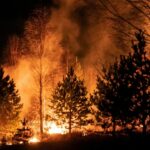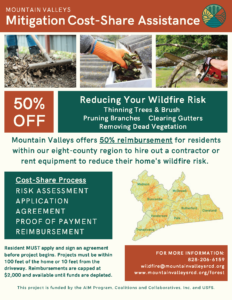Wildfire Mitigation Cost-Share Program
go.ncsu.edu/readext?872602
en Español / em Português
El inglés es el idioma de control de esta página. En la medida en que haya algún conflicto entre la traducción al inglés y la traducción, el inglés prevalece.
Al hacer clic en el enlace de traducción se activa un servicio de traducción gratuito para convertir la página al español. Al igual que con cualquier traducción por Internet, la conversión no es sensible al contexto y puede que no traduzca el texto en su significado original. NC State Extension no garantiza la exactitud del texto traducido. Por favor, tenga en cuenta que algunas aplicaciones y/o servicios pueden no funcionar como se espera cuando se traducen.
Português
Inglês é o idioma de controle desta página. Na medida que haja algum conflito entre o texto original em Inglês e a tradução, o Inglês prevalece.
Ao clicar no link de tradução, um serviço gratuito de tradução será ativado para converter a página para o Português. Como em qualquer tradução pela internet, a conversão não é sensivel ao contexto e pode não ocorrer a tradução para o significado orginal. O serviço de Extensão da Carolina do Norte (NC State Extension) não garante a exatidão do texto traduzido. Por favor, observe que algumas funções ou serviços podem não funcionar como esperado após a tradução.
English
English is the controlling language of this page. To the extent there is any conflict between the English text and the translation, English controls.
Clicking on the translation link activates a free translation service to convert the page to Spanish. As with any Internet translation, the conversion is not context-sensitive and may not translate the text to its original meaning. NC State Extension does not guarantee the accuracy of the translated text. Please note that some applications and/or services may not function as expected when translated.
Collapse ▲Financial Assistance for Reducing Wildfire Risk
 During a wildfire all kinds of plant material can act as fuel for the fire – grasses, shrubs, trees, dead leaves, and fallen pine needles. The extent and density of this plant material around a structure, like your home, can influence the ability of firefighters to stop the fire from igniting the structure. By thinning and managing fuels out to 100 feet you’re creating a buffer area between a build-up of fuel for the fire (dense vegetation) and your home, lowering the intensity of a fire as it approaches your home. We call this buffer area your home’s defensible space.
During a wildfire all kinds of plant material can act as fuel for the fire – grasses, shrubs, trees, dead leaves, and fallen pine needles. The extent and density of this plant material around a structure, like your home, can influence the ability of firefighters to stop the fire from igniting the structure. By thinning and managing fuels out to 100 feet you’re creating a buffer area between a build-up of fuel for the fire (dense vegetation) and your home, lowering the intensity of a fire as it approaches your home. We call this buffer area your home’s defensible space.
With the cost of everything going up, spending money to thin and remove trees on your property may be the last thing you want to do. We don’t want the cost of wildfire mitigation work to stop you from taking care of your home. That is why we sought funding to help residents complete their mitigation priorities to build and maintain their home’s defensible space. Through our mitigation cost-share assistance program the cost of tackling projects to reduce your wildfire risk can be cut in half!
Mountain Valleys RC&D is offering 50% reimbursement rate to homeowners who hire a contractor or rent equipment to build a defensible space by managing vegetation within 100 feet of their home and 10 feet from their driveway.
This program currently assists primary residents living in the following Western North Carolina counties: Buncombe, Madison, Henderson, McDowell, Polk, Transylvania, Cleveland, & Rutherford Counties.
Learn more from this blog post, Mitigation Cost-Share Program.





